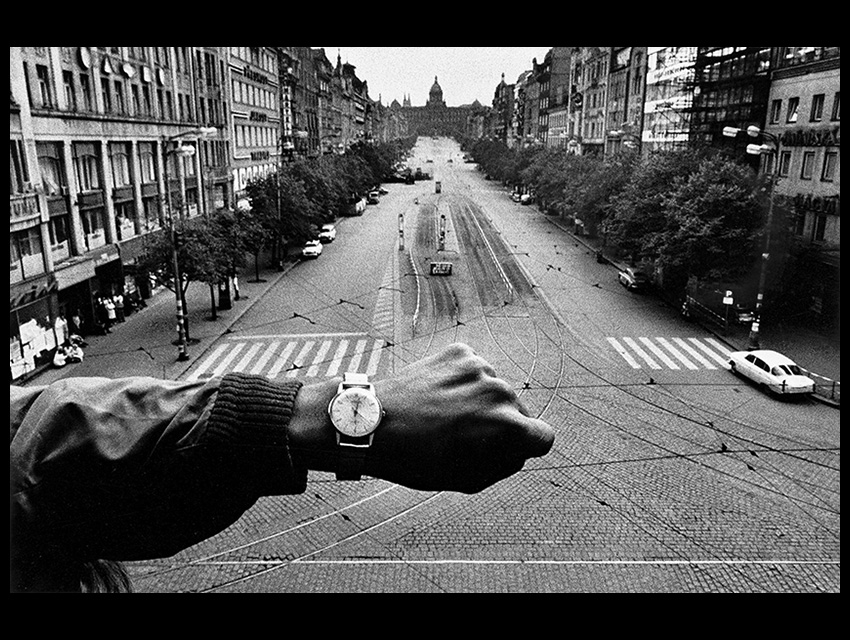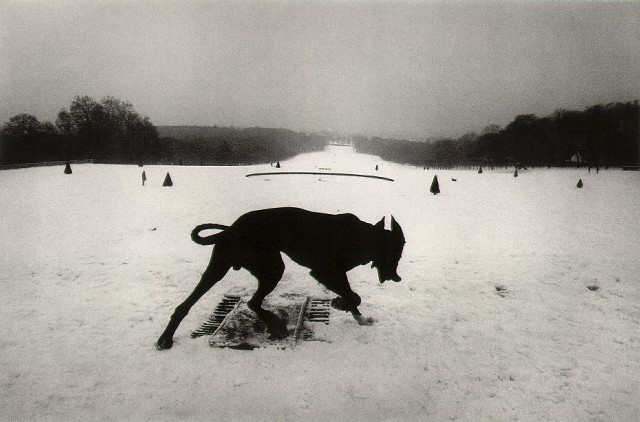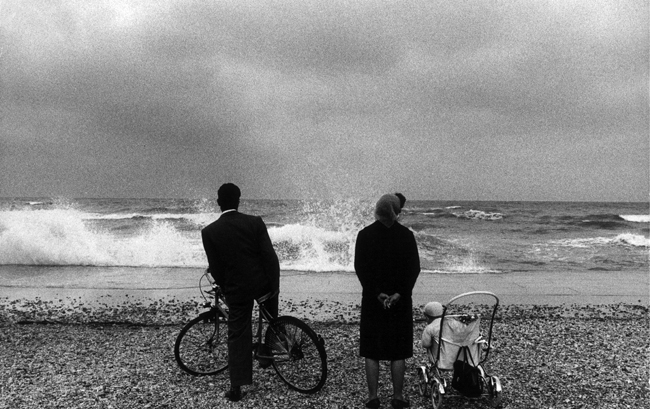
Josef Koudelka, Wenceslas Square, Prague, 22 August 1968, 5:01 PM
The view is in black and white, the grainy look of 1960’s era black and white film so typical of the journalistic photography of the time. The photo has the greyish cast of an overcast central European late-afternoon, what’s left of the day’s sun hidden somewhere behind a sky of low, scuttering clouds. Josef Koudelka, the Czech photographer taking the photo, has framed the photo horizontally in a 2:3 format, a function of the 35mm film used by the Exacta camera he was known to use throughout the ’60s. The photo is a view onto Wenceslas Square in Prague, Czechoslovakia on the afternoon of August 22, 1968. 5:01 PM to be precise. The photographer’s perspective seems to be a few floors up, seemingly in the middle of the Square itself, probably standing atop whatever monument graces the center of the Square.
Wenceslas Square, stretching out to a vanishing point, is empty, devoid of automobile or pedestrian traffic, although there are a few tiny, out-of-focus bystanders at the lower-left edge of the frame, some of them crouched together in what looks like commiseration of some sort. In the close foreground, a disembodied arm with wristwatch intrudes into the frame from the lower left, the watch face and the arm’s clenched fist positioned in the lower middle of the frame where it draws the viewer’s eye as the first plane of focus, but low enough that one’s glance wants to shift fore and aft, first the arm and wrist, then the Square behind, then the wrist again and the watch with its face on display. Presumably, the arm and fist and wristwatch belong to the photographer. The wristwatch says the time is 5:01.
Absent context, it’s unclear what this photo is asking of the viewer. The choice of black and white points to a documentary intent, although the view offered by Koudelka is banal, confusing, without an easily identified subject on which to focus. The camera’s optical focus is on the arm; the compositional focus seems to be both the Square and the watch, although, without further context, we’re not given any clues to make sense of which might have priority or what the relationship is, if any, between the two subject planes. While there’s a superficial inertia to the composition created by the compositional elements – no visible movement to be seen – upon closer viewing there’s a balanced tension radiating from the composition, a tension charged with potential energy that suggests something is about to happen, soon. The wristwatch, its minute hand in a wonky, off-axis position, connotes not stasis, but its opposite, an impending action about to shatter the delicate equilibrium of the captured moment. What it is that’s going to happen seems to be in the balance. The truth of the photo seems to be a function of the past, the present, and the future, whether it be more of what appears to be a temporary lull or rather of developing conflict and sinister atrocity. It’s as if the photographer, and us as viewers, are waiting for something to happen to help us finally make sense of what we see.
Determining anything more from within the four corners of the photo is futile. To understand what Koudelka is trying to tell us, we need context.
*************

On Wednesday, August 20, 1968, soldiers from the USSR, the German Democratic Republic, the Polish People’s Republic, the Hungarian People’s Republic and the Bulgarian People’s Republic invaded the Czechoslovak Socialist Republic and occupied the Czech capital of Prague. The invasion was led Soviet troops at the behest of the leaders of the Communist Party of the Soviet Union in response to the spontaneous Czechoslovak socio-political movement called the “Prague Spring,” wherein Czechoslovakia’s Communist leadership experimented with various political and social reforms deemed unacceptably liberal by Soviet standards.
Via a declaration by Czech leaders conveyed to the “People of Prague” by radio on the morning of August 21, both the Czech Army and Czech citizenry were ordered to stand down and not engage in any provocation or retaliation, as such would be counter-productive to the stated aims of the Prague Spring: “We call upon the people of Prague, in particular, the workers – Prevent any possible provocation! At this moment, defense by force is impossible! Our defense must be a dignified, prudent approach, unswerving loyalty to the process we began in January! In response, the Czech citizens who flooded the streets of Prague restricted their outrage to shouting slogans and peaceful resistance. Yet, as more residents crowded into the streets and surrounded the invader’s tanks and troop transports, Soviet soldiers fired into the crowd, killing a number of Czechs. Czechoslovak Communist Party leaders were arrested and removed to locations outside Prague and martial law was declared throughout the country, including a ban on public assembly. By that night, given limited knowledge of the Soviet dictated curfew, the occupying forces were driving their vehicles into the crowds and shooting random protestors who remained on the streets.
The next morning, August 22, Prague’s streets were empty. But as the day progressed, the news spread that there was to be a massive demonstration on Wenceslas Square at five o’clock. It was, in fact, a Soviet provocation, meant to provide a justification for the occupiers to crack down further. Warsaw Pact tanks and troop transports idled in the streets outside the Square, awaiting the arrival of what was expected to be massive crowds of Czech resisters. Czech Radio, still in the hands of Czech partisans, pleaded with its listeners to stay inside; the alternative would be a massacre. The question was – would the residents of Prague stay home?
At 5:01 Koudelka took the photo. His wristwatch tells you as much.
*************

There are two aspects of ethics implicated in the practice of conflict photography: 1) the doing of it, i.e. can the practice itself be justified ethically, or is it, as critics claim, inherently voyeuristic and exploitative; and 2), if it can be justified ethically, is a justification dependent on the specifics of the practice i.e. are some ways of doing conflict photography ethically justified while others are not?
The ethical premise which justifies conflict photography as a practice is this: the photographer will be a passive observer of what’s happening in return for being able to document it. This presupposes a stance of non-intervention on the part of the photographer, whose role as witness precludes active participation in what’s being witnessed. This is what allows the photographer to stand passively aside while a Viet Cong prisoner is summarily executed on a Saigon street, or as an emaciated child lies helpless in the dirt while a vulture hovers nearby, waiting for the inevitable. The act of documenting is meant to serve a higher ethical purpose, that of educating others about what’s happening, with the understanding that the knowledge imparted by the photographer’s witness will motivate others to act.
Those others are us, the viewers. As such, we’re implicated ethically as well. The unsettling reality we’re confronted with is not simply the photographer’s ethical obligation but ours as viewers. Our response, however, is dependent to a large extent on what we’re given by the photographer. The photographer is the curator of what the viewer will see and how they will see it. The photographer must choose what to show and what not to show. This is where his power lies, it’s part of his obligation in the process, and it’s where the second ethical aspect of the practice of conflict photography is implicated. How a photographer ‘frames’ what he is presenting will constrain the potential range of viewer response. By ‘framing’, I mean both the technical specifics of the photo, but also what is chosen to be seen and what is chosen not to be seen, and, to my mind, what’s most important, the context within which the photo is presented. If the ultimate end of conflict photography practice is to activate an ethical response from the viewer, then the photographer’s responsibility is to present what’s being documented in a manner both factually and ethically true to the narrative the photographer is ‘documenting.’
Conflict photography, by definition, always has a didactic purpose. This is true, to some extent, of all photography. A photo isn’t simply a statement of fact; it is always, in some sense, an argument. As Susan Sontag notes in her monograph Regarding the Pain of Others, it is “both objective record and personal testimony, both a faithful copy or transcription of an actual moment of reality and an interpretation of that reality.” It’s only within a context that the photo can serve the purpose presupposed by the premise. A photo without context quickly floats free of any meaning imposed upon it by the photographer. If a photo isn’t given form by a narrative sequence, or description, or accompanying text, then it’s the viewer who will bring that context to the photo. And ultimately, if the viewer is left to impose meaning on the conflict photo without guidance from the photographer, the photographer has abdicated his/her ethical responsibility.
Given the didactic purpose of conflict photography, the issue of rhetorical strategy has always occupied a necessary role in the genre. Magnum Photos was founded with a moral perspective on injustice which was specific to its mission. Magnum photographer Abbas Attar, better known by his mononym ‘Abbas’, reflects the means to that end when he says “I am interested in the world, sure, but also in my vision of the world…I try to show my point of view.” As for the specific content of Magnum’s mission, Magnum member Philip Jones Griffiths epitomizes the didactic tendency of Magnum’s photography: “There is no point in pressing the shutter unless you are making some caustic comment on the incongruities of life.”
As the genre has progressed – from the ‘Heroic’ WW2 images of Capa, Chim and Rodgers to the ‘Ironic’ images of Larry Burrows’ Viet Nam era work, to 90’s era work of Giles Peress and Susan Meisalas – conflict photographers’ rhetorical strategies have become more self-consciously evident, more an obvious feature of the work. This has been the consequence both of the imagery itself, the images “more dynamic,” the pictorial emphasis on the action of conflict itself, and, with the passing of the photo magazines like Life and Look, the narrative structures in which those images have been placed. Where Life era photographers were often constrained by the editorial prerogatives of military authority and the publishing magazine, more recent conflict photographers have the ability to publish extended photo monographs that highlight their unique ethical perspectives uncompromised by bureaucratic, social or military obstruction.
In spite of the stated ethical emphasis of recent conflict photography, much of it, when wrenched out of context, as it too often is, seems gratuitous, appealing to a viewer’s baser human motives. A glimpse of an image, usually of graphic violence and human suffering, shorn of the context the viewer would need to properly understand it, appeals to viewers’ baser motives and serves no real purpose but to titillate. Traditional conflict photography tropes that utilize images of atrocity are often counter-productive, exploiting those they mean to advocate for by re-victimizing them, while causing compassion fatigue for viewers. The “forensic aesthetic”, currently in vogue, where victim and violence remain outside the frame and the photographer documents the spaces associated with the conflict, is a response to such criticisms.
*************

I’ve long been an admirer of Josef Koudelka’s photography. A member of Magnum, he’s been producing exceptional photojournalistic work since the early 1960s, most notably his depictions of Roma (“Gypsy”) culture, which Magnum published in book form in 1975, and his documentation, at great personal risk, of the Warsaw Pact invasion of Prague in 1968. Koudelka brings a unique aesthetic to his documentary work, producing some of the most beautiful and sumptuous film photography of his era. While he considers himself a photojournalist, his works can be found in the collections of The Museum of Modern Art in New York, the Art Institute of Chicago, the Los Angeles County Museum of Art, and the Victoria and Albert Museum in London, among many others. It’s the tension between his aesthetics and his subject matter that gives Koudelka’s work its bite, but it also leaves him open to the standard criticisms of any documentary work that retains a strong imprint of the documentarian’s subjective eye.
Koudelka’s Wenceslas Square photo is one of his most reproduced. It’s often found in anthologies of his work, one of the iconic photos for which he is known. This has always confused me, because my exposure to it has been within the context of my appreciation of Koudelka as an artist, someone whose work I appreciated for its formal beauty and coherence. Wenceslas Square, Prague, 22 August 1968, 5:01 PM, doesn’t possess the grand aesthetic beauty Koudelka is known for. It appears uncontrived, almost accidental in its form, more of a throw-away than most of his mannered work. To put it simply, it isn’t that good of a photo if one’s criterion is formal interest. Yet, it’s considered one of his iconic photos.
The reason, of course, is context, or the lack thereof. To understand and appreciate the photo the viewer must be privy to the historical, social and political context within which the photo operates. You’ve got to know the backstory, the specifics of the conflicting parties, the historical, social and political currents that are in the process of intersecting in Wenceslas Square in Prague on August 22, 1968, at 5:01 in the afternoon. If you have that context, the photo is now charged with meaning. It makes sense. You can understand what Josef Koudelka is trying to tell you.
Ostensibly, Koudelka’s subject is an “old style” subject, the heroic resistance of a nascent democratic movement with world-historical consequences. Much of Koudelka’s Prague Spring work retains that traditional didactic style, the style made famous by Capa and Chim and Rodgers. But the photo in question – the Wenceslas Square photo – has more in common with current forensic approaches. Koudelka has always been a cerebral photographer, and at some level, he meant this simple, uncontrived photo to possess a conceptual complexity that would require de-coding by the viewer, much like what’s required of current forensic approaches. Why else place that forearm and watch as a central pictorial element? I read the photo as Koudelka’s rejoinder to the ethical problems inherent in conflict photography. It’s conflict photography as meta-narrative, a conflict photo that comments on the practice of conflict photography itself.
Superficially, the photo is a factual description – ‘this is what Wenceslas Square looks like at this time’. No coherent story is denoted, no Romantic trope of sacrifice or heroism. No encouragement of broader connotative issues. No good vs. bad, right vs. wrong. It leaves the didactic message, if any, embedded in the broader context within which the photo exists.
The photo itself is sui generis, there’s no falling back on previous tropes or personal signatures. It is screaming for context, a context that the photograph, standing on its own, can’t provide. Koudelka seems to be playing on this issue of context, his photo, standing by itself, a black box, indecipherable as to motive or allegiances, a screen onto which the viewer must project their passions, beliefs, and biases if they’re to make any sense of it.
The indecipherability is accentuated by the absence of action. It makes the viewer think, question. Whatever the photograph’s attraction, it isn’t dependent on titillation nor is it exploitative in any way. The photo suggests dynamic forces operating underneath the surface calm. What those forces are, and what message they reveal, waits for the context in which they operate. In this respect, it’s honest, deferring to the inherent limitations of conflict photography and, in effect, utilizing them to comment on the practice itself. It’s almost as if Koudelka is posing himself – and his viewers – a question.
Through all of this there’s a person behind the camera, the person with the arm and the watch, presumably the person of Koudelka who ‘takes’ the photo. Koudelka is reminding us that photos aren’t disembodied statements of fact; they are subjective views, the result of infinite choices made by the photographer – where to be, when to be there, what to include, what not to include. ‘Oh, and by the way, don’t forget I’m back here, staging all of this for you’, he seems to be saying.


